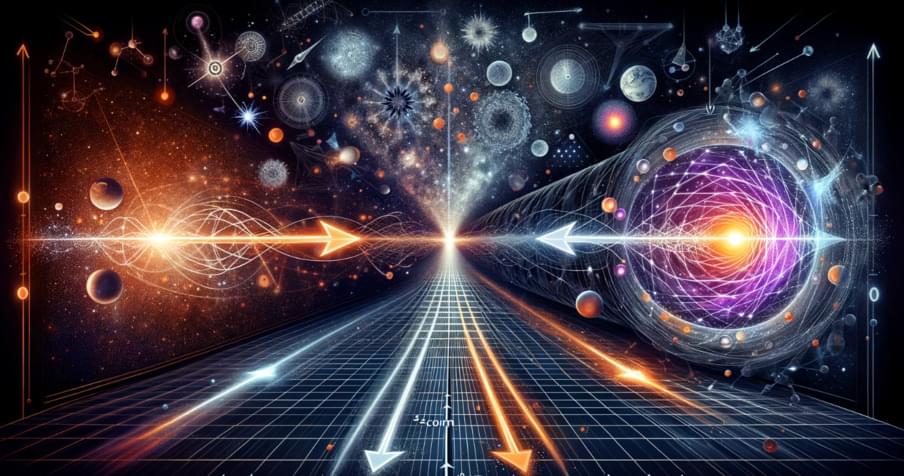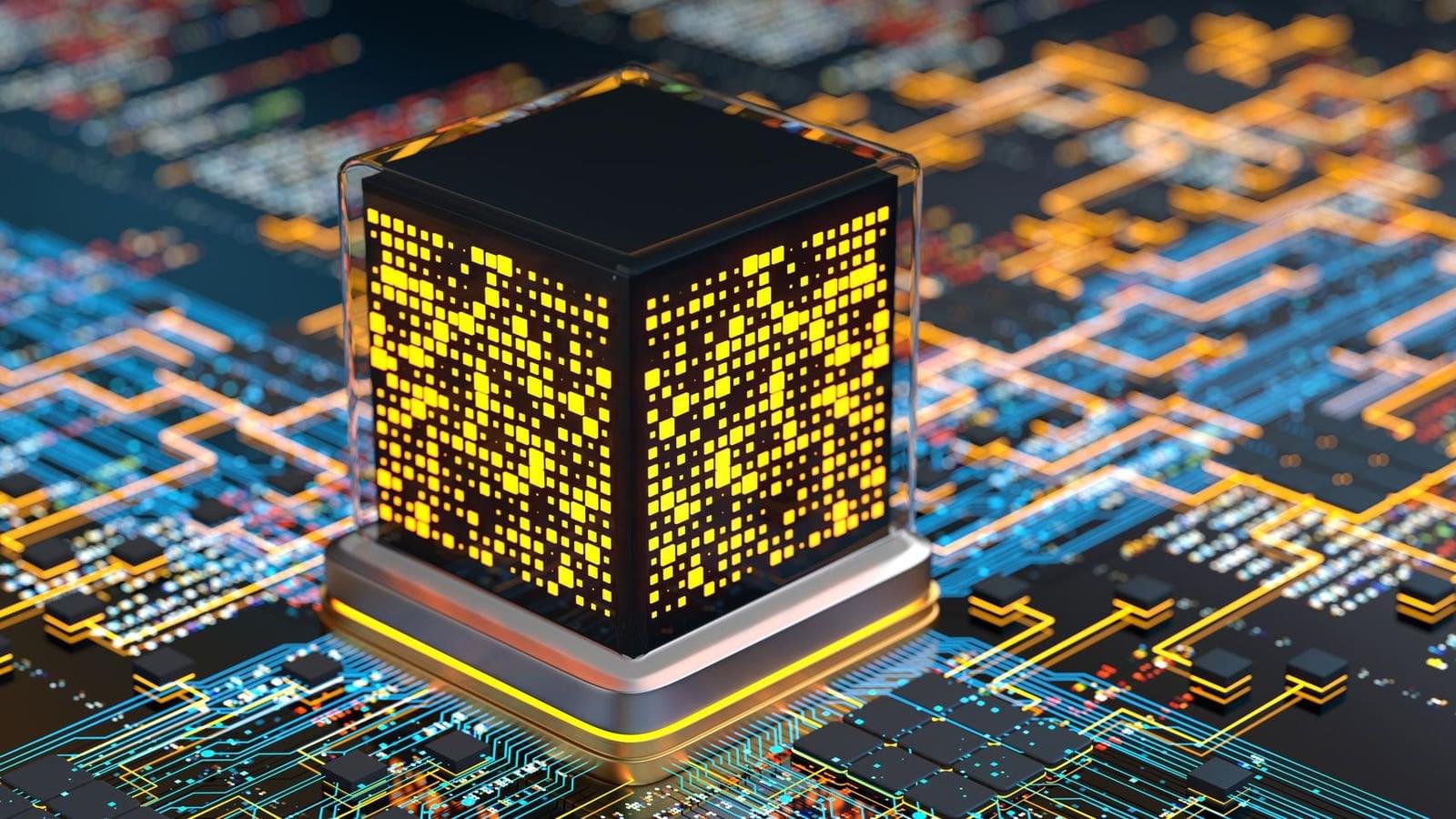Capturing Electron Motion at Unthinkable Speeds
Electrons oscillate around the nucleus of an atom.
An atom is the smallest component of an element. It is made up of protons and neutrons within the nucleus, and electrons circling the nucleus.



Please see my latest Forbes article on the need to get ready for the Quantum Era. Thanks!
By Chuck Brooks, Forbes Contributor. Global Thought Leader in Cybersecurity and Emerging Tech.
“We are on the emerging pathway to the new era of quantum computing. We must now prepare for the exponential benefits and risks of quantum technologies.”
https://search.app/SbiN8RJWMdDx39ac8
#quantum #quantumcomputing #tech #cybersecurity #artificialintelligence

Scientists have now mapped the forces acting inside a proton, showing in unprecedented detail how quarks—the tiny particles within—respond when hit by high-energy photons.
The international team includes experts from the University of Adelaide who are exploring the structure of sub-atomic matter to try and provide further insight into the forces that underpin the natural world.
“We have used a powerful computational technique called lattice quantum chromodynamics to map the forces acting inside a proton,” said Associate Professor Ross Young, Associate Head of Learning and Teaching, School of Physics, Chemistry and Earth Sciences, who is part of the team.

Photonics researchers from Tampere University, Finland, and Kastler-Brossel Laboratory, France, have demonstrated how self-imaging of light, a phenomenon known for nearly two centuries, can be applied to cylindrical systems, facilitating unprecedented control of light’s structure with great potential for advanced optical communication systems. In addition, a new type of space-time duality was explored for powerful analogies bridging different fields of optics.
In 1836, Henry F. Talbot performed an experiment, where he observed light patterns that naturally reappear after some propagation without the use of any lenses or imaging optics—a self-imaging phenomenon nowadays of then termed the Talbot effect.
Recently, researchers interested in sculpting light from the Experimental Quantum Optics Group (EQO) in Tampere University, as well as the Complex Media Optics group at Kastler Brossel Laboratory, in Ecole Normale Supérieure, Paris, have teamed up and investigated the self-imaging Talbot effect in cylindrical systems in greater depth than ever before. The presented interesting fundamental physics and powerful applications in optical communications have now been published in the journal Nature Photonics.

‘Quantum Supremacy’ author Dr. Michio Kaku discusses the future of quantum computing on ‘Making Money.’ #foxbusiness #makingmoney.
Watch more Fox Business Video: https://video.foxbusiness.com.
Watch Fox Business Network Live: http://www.foxnewsgo.com/
FOX Business Network (FBN) is a financial news channel delivering real-time information across all platforms that impact both Main Street and Wall Street. Headquartered in New York — the business capital of the world — FBN launched in October 2007 and is one of the leading business networks on television. In 2025 it opened the year posting double-digit advantages across business day, market hours and total day viewers in January. Additionally, the network continued to lead business news programming, with each business day program placing among the top 15 shows, while FBN delivered its highest-rated month since April 2023 with market hours.
Follow Fox Business on Facebook: / foxbusiness.
Follow Fox Business on Twitter: / foxbusiness.
Follow Fox Business on Instagram: / foxbusiness.
“Retrocausality” by Antonella Vannini and Ulisse Di Corpo Book Link: https://amzn.to/3X6UGhx.
“Time Loops: Precognition, Retrocausation, and the Unconscious” by Eric Wargo Book Link: https://amzn.to/4bdmWVV
“Psychology and Retrocausality: How the Future Determines Love, Memory, Evolution, Learning, Depression, Death, and What It Means to Be Human” by Mark Hatala Book Link: https://amzn.to/4k7kdBj.
The exploration of retrocausality challenges classical views of time and causality, suggesting that effects can precede their causes, influencing our understanding of quantum mechanics, consciousness, and free will. Retro causality offers potential resolutions to issues like non-locality in quantum physics by allowing communication between particles to travel backward in time, which could eliminate the need for higher dimensional configuration spaces and reconcile quantum theory with special relativity. Experimental investigations into retro-causality involve analyzing subtle effects, such as heart rate variations, and require careful methodologies to distinguish genuine retrocausal phenomena from experimental artifacts, while theoretical frameworks explore how retrocausality might address paradoxes and be compatible with concepts like time symmetry.
Thinkers in physics and philosophy are increasingly considering retrocausality as a potential framework to address foundational issues, including the measurement problem and the reconciliation of quantum mechanics with general relativity, potentially impacting our comprehension of time, causality, and the nature of reality itself. Discussions around retrocausality extend into areas like decision theory, existential risk, and the nature of consciousness, with some researchers exploring goal-oriented approaches and the potential for retrocausality to enhance artificial intelligence and our understanding of human cognition. Some notable scientists involved:
• Roger Penrose is noted for his views aligning with retrocausal concepts and his work on the science of consciousness with Stuart Hameroff.
• Yakir Aharonov is cited regarding time in quantum mechanics and weak value amplification.
• Ruth Kastner is mentioned in the context of retrocausality and the transactional interpretation of quantum mechanics.
• Hu Price’s work is at the center of the study of existential risk.
• Ken Wharton is a professor of physics and astronomy working on time-symmetric and causally neutral models of physics.
• Matthew Leifer is mentioned regarding block universe ontological models and frameworks for theories with retrocausality.
• Daniel Rohrlich is mentioned for his work on fundamental aspects of quantum mechanics and his views on retrocausality.
• Richard Feynman is mentioned in the context of interaction with the absorber as the mechanism of radiation.
• Simon Shnoll is mentioned for his work showing that the assumption of normal distribution is only mathematical, and that in life sciences and also in physics it is false.
• David Lucas is mentioned in the context of trapped-ion processing modules.
#Retrocausality #QuantumPhysics #TimeTravel #Physics #Science #Philosophy #Cosmology #Reality #Consciousness #MindBodyProblem #QuantumMechanics #Time Symmetry #Causality #Determinism #Parapsychology #time #physics #cosmology #Timelessness #PhilosophyofTime #Spacetime #GeneralRelativity #TimeCapsules #SuperstringTheory #aideepdive #InfiniteUniverse #podcast #synopsis #books #bookreview #science #quantumphysics #aiart #artificialintelligence #booktube #aigenerated #reality #videoessay #documentary
Quantum computing will never be the same again. Join host Konstantinos Karagiannis for a special onsite interview at Microsoft Azure Quantum labs, where he was invited to see the launch of Majorana 1, the world’s first quantum processor powered by topological qubits. On the day this episode is posted, Nature will release a paper validating how Microsoft was able to create a topoconductor, or new material stack of indium arsenide and aluminum, built literally one atom at a time, to bring quantum particles called Majoranas into usable form. The resulting topological qubits have a unique shape called a tetron and can be accurately measured with lower errors than other modalities. Starting with a 4×2 grid of qubits, this same tiny device will hold 1 million qubits in a few years because of its unique system of wiring and measurement. This interview with Chetan Nayak from Microsoft happened a few feet away from a working Majorana 1 system.
For more information on Microsoft Azure Quantum, visit https://quantum.microsoft.com/.
Read the technical blog here: https://aka.ms/MSQuantumAQBlog.
For photos from the Microsoft labs and other links, visit @konstanthacker on X and Instagram.
Visit Protiviti at www.protiviti.com/US-en/technology-consulting/quantum-computing-services to learn more about how Protiviti is helping organizations get post-quantum ready.
Follow host Konstantinos Karagiannis on all socials: @KonstantHacker and follow Protiviti Technology on LinkedIn and Twitter: @ProtivitiTech.
Visit Microsoft Azure Quantum here to learn about quantum computing for free https://quantum.microsoft.com/?ocid=2… https://quantum.microsoft.com/en-us/e… Topological quantum computing is a brand new form of quantum computing being developed by Microsoft as they enter the race to build the world’s first useful quantum computer. In this video I visited Microsoft’s quantum labs to see how they are making their topological quantum computers and learn how topology helps their quantum devices avoid noise by harnessing the power of Majorana quasiparticles which are made from an exotic form of superconductivity where the electrons behave like there is a Majorana particle there which has the special properties of topology.
Get My Posters Here.
For North America visit my DFTBA Store: https://store.dftba.com/collections/d… the rest of the world go to my RedBubble Store: https://www.redbubble.com/people/Domi… I have also made posters available for personal or educational use which you can find here: https://www.flickr.com/photos/9586967… Some Awesome People And many thanks to my $10 supporters and above on Patreon, you are awesome! Join the gang and help support me produce free and high quality science content: / domainofscience Tut Arom Anja Jason Evans machinator rimor Mirik Gogri Eric Epstein Sebastian Theodore Chu My Science Books I also write science books for kids called Professor Astro Cat. You can see them all here: https://flyingeyebooks.com/book/profe… http://profastrocat.com Follow me around the internet http://dominicwalliman.com
/ dominicwalliman
/ dominicwalliman Credits Writer, art, animation and edited by Dominic Walliman I use Adobe Illustrator and After Effects for the graphics (for the many people who ask smile References “InAs-Al hybrid devices passing the topological gap protocol” https://journals.aps.org/prb/abstract… “A cryogenic CMOS chip for generating control signals for multiple qubits” https://www.nature.com/articles/s4192… Topological qubit noise levels — “Assessing requirements to scale to practical quantum advantage” chrome-extension://efaidnbmnnnibpcajpcglclefindmkaj/ https://arxiv.org/pdf/2211.07629 Chapters 00:00 Topological Quantum Computing 02:01 Topology Explained 04:47 Resilience to Noise 05:51 Anatomy of a Quantum Computer 07:05 Chip Fabrication and Lab Tour 09:41 How to Build a Quantum Computer 11:21 Topological Quantum Computing Lego Explainer 15:40 Microsoft’s Results 17:50 Majorana Particle Explained 21:31 Sponsor Message 23:03 Thanks Patrons!
For the rest of the world go to my RedBubble Store: https://www.redbubble.com/people/Domi…
I have also made posters available for personal or educational use which you can find here: https://www.flickr.com/photos/9586967…
Some Awesome People.
And many thanks to my $10 supporters and above on Patreon, you are awesome!
Join the gang and help support me produce free and high quality science content:
/ domainofscience.
Tut Arom.